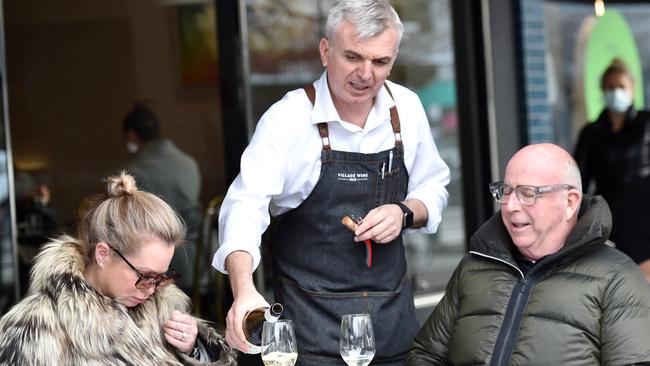Job losses masked by care economy
More than 90,000 jobs have been shed in hospitality over the past year, but taxpayer-funded ‘care economy’ roles have masked the losses, driving a 375,000 jump in jobs being created.

More than 90,000 jobs have been shed in hospitality over the past year, 26,000 lost in wholesale trades and 6000 in manufacturing, but taxpayer-funded “care economy” roles have masked the losses, driving a 375,000 jump in jobs being created.
Across the last financial year, there were 171,000 jobs filled in health and social assistance, 63,000 in public administration and 47,000 in education and training.
Approximately two-thirds of the jobs created under the Albanese government have been in the so-called “non-market sector”, comprising the public sector, education and healthcare, even as they account for just 17 per cent of the total economy.
The analysis of jobs data by The Australian comes as Reserve Bank deputy governor Andrew Hauser warned that inflation and interest rates would stay higher in Australia, given its “deliberate choice” not to tighten as much as other central banks to preserve bumper employment growth.
“By implication [that means interest rates] probably not easing as quickly or by as much,” Mr Hauser told a conference hosted by Commonwealth Bank in Sydney.
“That has the implication … that inflation will drift only quite gradually, or underlying inflation will only drift quite gradually back to target.” According to its own forecasts, the RBA expects inflation will sustainably return to its 2 to 3 per cent target band by the end of 2026.
Australian Hotels Association chief executive Stephen Ferguson said part of the reason there were fewer jobs in the hospitality industry over the past year was because workers were leaving for other sectors.
He said labour shortages persisted in accommodation and hospitality, with regional areas most acutely affected. “During the pandemic we lost a lot of more experienced and middle management (staff),” Mr Ferguson said.
“The employment was so unreliable, they left the industry. There’s still a lag from then.”
The decline in employment in the sector was also coming at a time when the industry was facing significant headwinds.
“Gross revenue in a business often might be the same, but their costs are just coming up from the bottom, which is really squeezing margins,” he said.
Last week, Jim Chalmers decried the “real snobbiness” of the Coalition’s criticism of the ballooning growth of the public sector and other taxpayer-funded sectors. “I completely reject this sense that it’s only a real job if it’s not in the care economy,” the Treasurer said on Friday, arguing Labor wanted workers in the sector to be “respected”.
While central banks in the US, New Zealand, Canada and Britain raised benchmark interest rates to at least 5 per cent, Australia’s own central bank increased the cash rate to 4.35 per cent as it attempted to preserve the nation’s post-pandemic jobs boom.
In the face of weakening labour markets, central banks in New Zealand, Canada and the Britain pressed ahead with rate cuts. The US Federal Reserve has also cut rates, however, the unemployment rate in the world’s largest economy remains low at 4.1 per cent.
In contrast, the RBA, which continues to battle a tight jobs market and sticky price pressures, is at the back of the pack in the global rush to cut interest rates.
Mr Hauser expressed his “surprise” at the resilience of the jobs market, which is part of the reason the RBA is not considering cutting rates.
“It’s quite a good news story, these labour market outcomes, both the level of unemployment at or near historical lows … and the level of labour market participation,” Mr Hauser said. “On average, firms are still telling us that whilst labour market conditions have become a bit easier, it’s still more or less the top factor constraining output growth.”
Employment surged by 64,100 last month, the Australian Bureau of Statistics reported last week, blistering past expectations of just 25,200 new positions, and holding the unemployment rate steady at 4.1 per cent.
The hotter-than-expected figures quashed expectations of a pre-Christmas rate cut, which RBA governor Michele Bullock had already effectively ruled out, and prompted economists to warn an easing of monetary policy risked further delay.
Following the release, investors also pared back their bets for interest rate relief, tipping a quarter-point cut in April. Previously, markets were fully priced for a rate cut at the RBA’s first meeting of 2025, scheduled for February.
September quarter inflation data, scheduled for release next week, will also be closely considered at the RBA’s November board meeting, where it is expected to keep rates on hold. Other figures released since the RBA’s last meeting have been relatively upbeat, with retail spending climbing to its highest level since January, while consumer sentiment has climbed to a 2½ -year high.




To join the conversation, please log in. Don't have an account? Register
Join the conversation, you are commenting as Logout